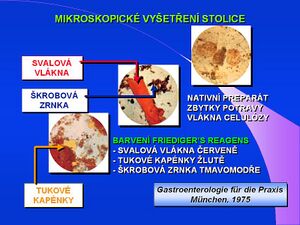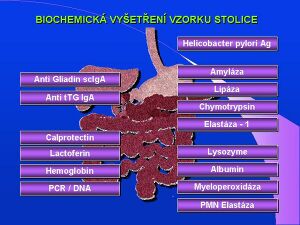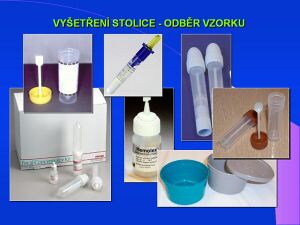Stool examination
Comprehensive examination of stool, from macroscopic assessment, determination of volume, structure, pH, to analytical determination of laboratory markers is considered to be the basic examination process in case of suspected malabsorption syndrome. The latest publications in internal medicine, gastroenterology and clinical biochemistry also provide a qualitative determination of the presence of undigested sugar, fats a proteins - microscopically evaluated stool staining. The methodology of microscopic stool staining, with illustrated color photographs, is last described in detail in Gastroenterology for Practice (Munich, 1975).
Immunotechnical methods[edit | edit source]
Modern immunotechnical methods today offer a wide range of analytes that can be determined in a single stool sample - eg Helicobacter pylori antigen , antibodies to gliadin and transglutaminase , pancreatic enzymes , inflammatory markers , hemoglobin , colorectal cancer markers . Quantitative analysis of stool, especially fats in a 72-hour collection, was recommended as the gold standard for the diagnosis of malabsorption more than 50 years ago. So far, this test is considered to be the most accurate method with a defined fat intake of 100 g per day, although it is routinely performed minimally, due to the process of collecting, storing and processing 600-1200 g of stool.
Stool examination[edit | edit source]
thumb|Vyšetření stolice – odběr vzorku Stool examination is a completely non-invasive approach. However, the issue of this type of test involves a significant risk of pre-analytical error, because for most tests the patient takes a stool sample and, for example, extracts the sample in a collection tube. Also, the storage of this primary sample cannot be laboratory controlled. Screening tests must therefore be designed robustly enough.
Development of molecular biology[edit | edit source]
The development of molecular biology and PCR applications in routine diagnostics open up completely new trends in GIT tumor screening as well. The latest screening methods are based on the detection of specific mutations by PCR or biochip technology in DNA isolated from a stool sample resp. isolated colonocytes.
Links[edit | edit source]
Related articles[edit | edit source]
- Examination methods in gastroenterology
- Laboratory methods in gastroenterology
- Functional tests in gastroenterology
Resources[edit | edit source]
- with the permission of the author taken from



